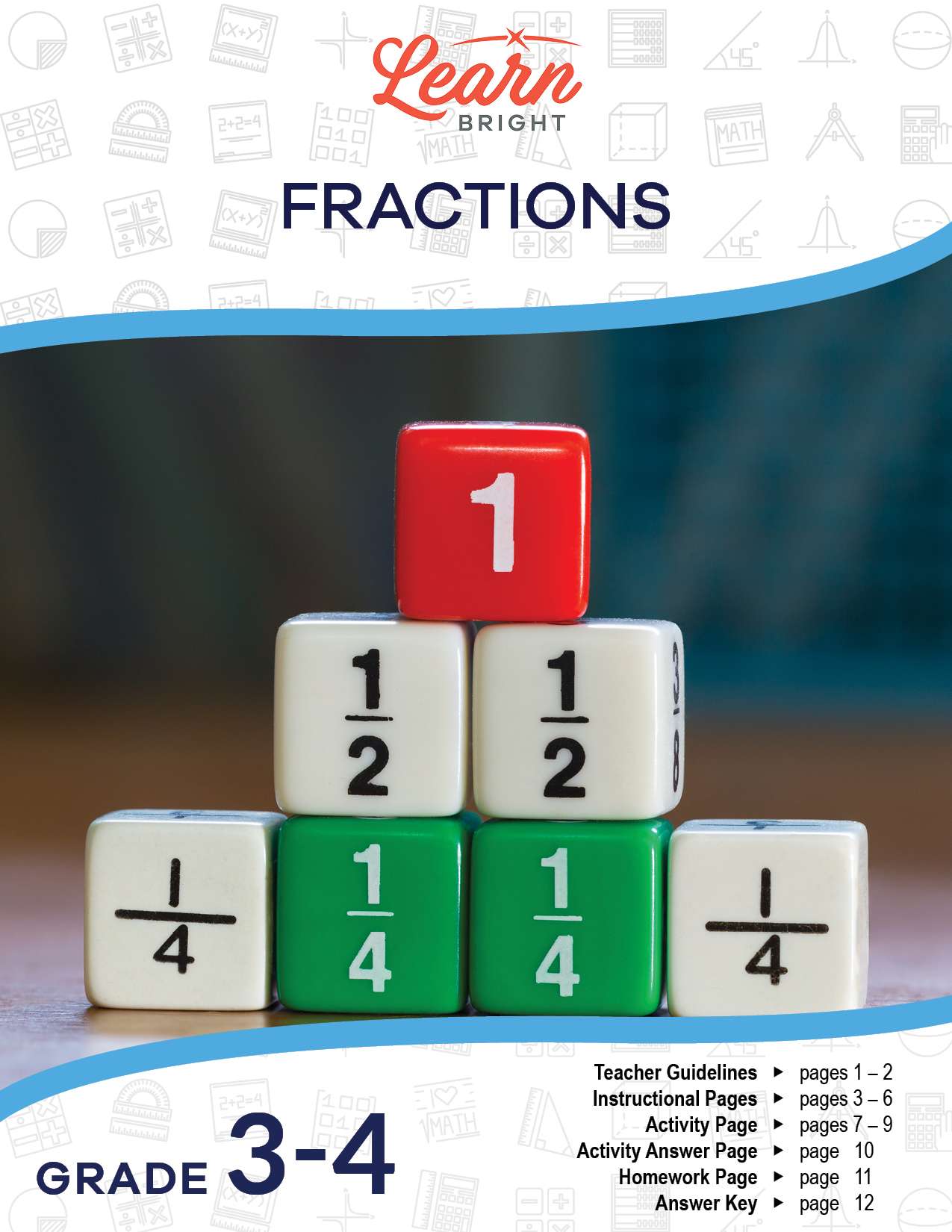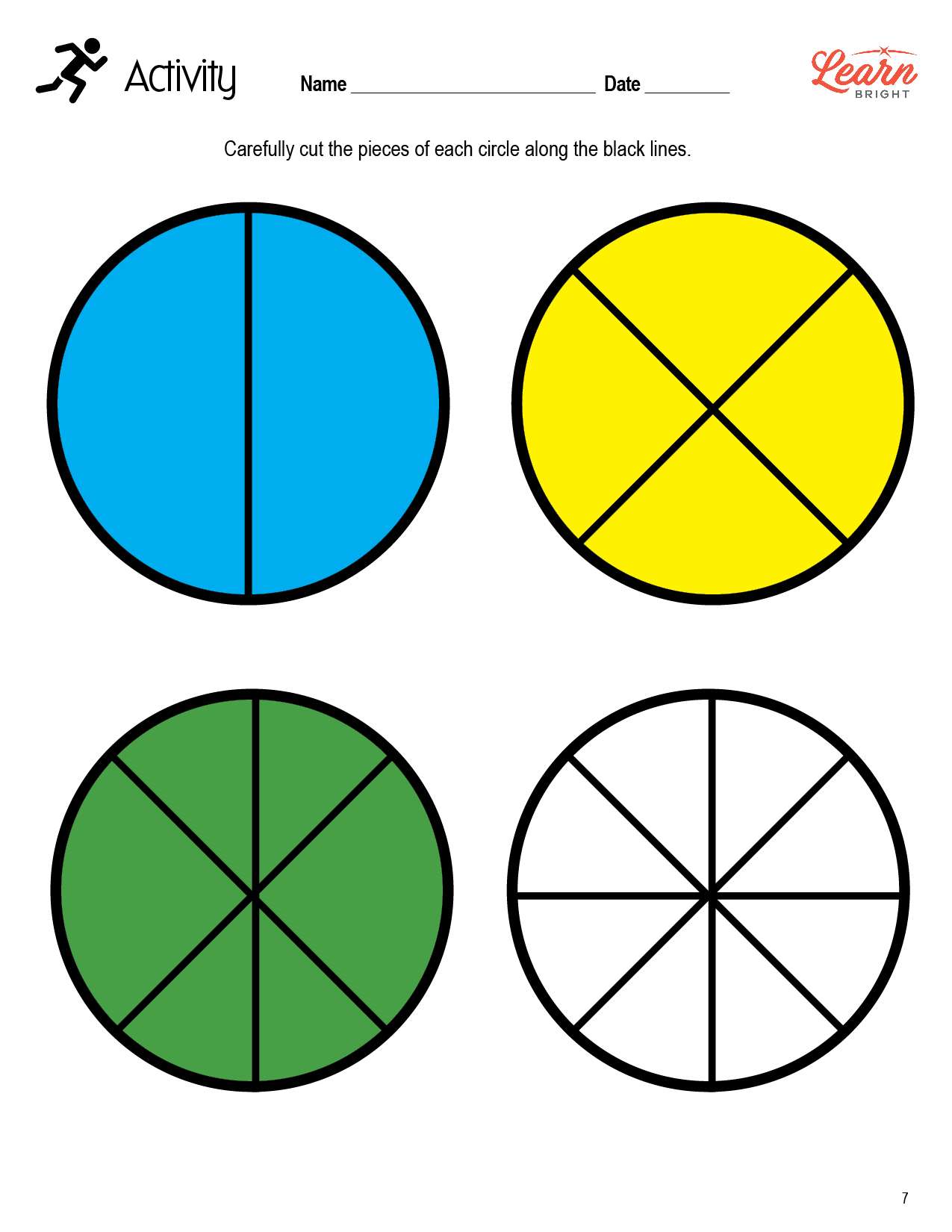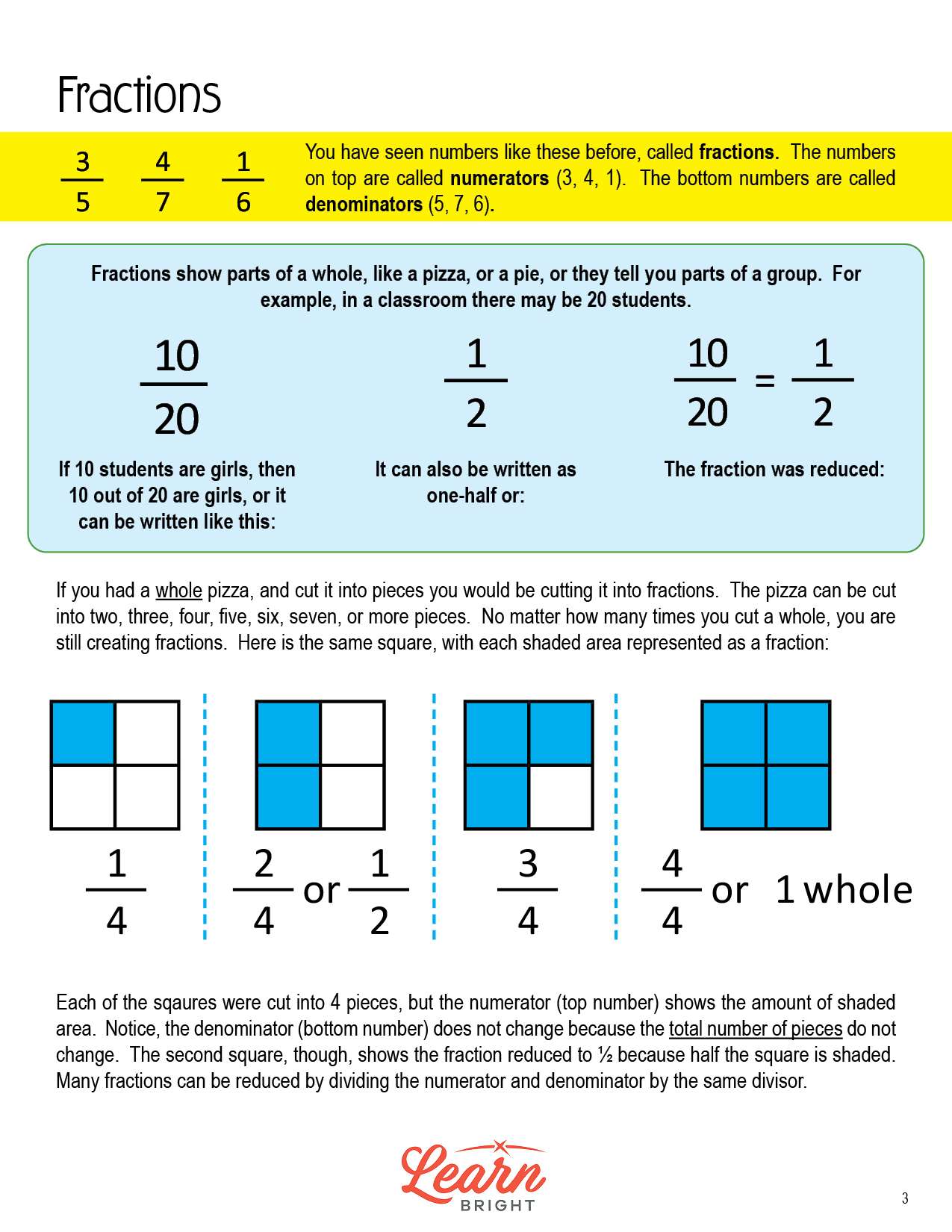Description
What our Fractions lesson plan includes
Lesson Objectives and Overview: Fractions enables students to identify fractions, the parts of a fraction, add/subtract like-denominator fractions, and reduce fractions. This lesson is for students in 3rd grade and 4th grade.
Classroom Procedure
Every lesson plan provides you with a classroom procedure page that outlines a step-by-step guide to follow. You do not have to follow the guide exactly. The guide helps you organize the lesson and details when to hand out worksheets. It also lists information in the blue box that you might find useful. You will find the lesson objectives, state standards, and number of class sessions the lesson should take to complete in this area. In addition, it describes the supplies you will need as well as what and how you need to prepare beforehand. The supplies that you need include counters, scissors, glue, and the handouts.
Options for Lesson
Included with this lesson is an “Options for Lesson” section that lists a number of suggestions for activities to add to the lesson or substitutions for the ones already in the lesson. You could use this lesson as a review for higher grades or as advanced work for lower grade levels. If you’d like to add additional practice problems to the lesson, you can copy extra circle pieces. If you have more advanced students, you can allow them to assist those who are having trouble understanding the lesson.
Teacher Notes
The teacher notes page includes a paragraph with additional guidelines and things to think about as you begin to plan your lesson. This page also includes lines that you can use to add your own notes as you’re preparing for this lesson.
FRACTIONS LESSON PLAN CONTENT PAGES
Fractions
The Fractions lesson plan includes four pages of content. In a fraction, the number on top is the numerator and the number on the bottom is the denominator. Fractions are part of a whole. Think of a pizza, a pie, or a group of students in a classroom. You might have 20 students in your class. If 10 of them are girls, then 10 out of 20 are girls. We can show this as a fraction: 10/20. We can reduce it to 1/2, or one-half. One half of students are girls.
If you cut a whole pizza into pieces, you’re cutting it into fractions. It doesn’t matter how many pieces you cut it into, you’re creating fractions. You can divide a shape into four pieces. Changing the top number, or the numerator, changes the fraction: 1/4, 2/4, 3/4, and 4/4. All of these have the same total number of pieces (4).
When you cut something into more pieces, the size of the whole does not change, but the pieces get smaller the more cuts you make. 1/2 of a pizza is bigger than 1/4 of a pizza is bigger than 1/6 of a pizza. We can write this using greater than symbols: 1/2 > 1/4 > 1/6.
Reducing Fractions
When you reduce fractions, you always use the largest divisor, also called the Greatest Common Factor (GCF). For example, if you want to reduce the fraction 4/8, the divisor could be 2, but you need to use 4 instead, because 4 is the GCF of 4 and 8. You should always reduce fractions to their lowest possible terms.
If you eat 1/2 of one pizza, and 2/4 of another, you’ve eaten the same amount of pizza. 1/2 = 2/4. We can reduce 2/4 to 1/2 by dividing it by the GCF, 2.
Adding and Subtracting Fractions
Adding and subtracting fractions is not much different from adding and subtracting whole numbers. It’s very easy to add fractions with the same denominators. All you need to do is keep the denominator as-is and add the numerators.
To add 2/5 and 1/5, for example, you simply add the numerators (1 + 2) for a final answer of 3/5. Make sure to reduce the final fraction if needed. For example, to add 3/8 and 3/8, we add the numerators to get an answer of 6/8. We can then reduce this fraction to our final answer of 3/4.
The steps for subtraction are the same, just using subtraction instead of addition! If the denominator is the same, you simply subtract the numerators. For example, for the problem 4/7 – 2/7, we simply subtract 2 from 4 for a final answer of 2/7. Like addition problems, you should make sure to reduce any fractions that you can.
Don’t be afraid of adding, subtracting, multiplying, and dividing fractions! If you can add, subtract, multiply, and divide whole numbers, you can do the same for fractions. The lesson closes with a few example problems for students to try.
FRACTIONS LESSON PLAN WORKSHEETS
The Fractions lesson plan includes two worksheets: an activity worksheet and a homework assignment. You can refer to the guide on the classroom procedure page to determine when to hand out each worksheet.
CIRCLES ACTIVITY WORKSHEET
The activity worksheet asks students to follow the instructions on the worksheet to correctly place colored circle pieces in the empty circles on the worksheet, writing each as a fraction.
FRACTIONS HOMEWORK ASSIGNMENT
For the homework assignment, students will add or subtract fractions. They will also add or subtract fractions and then reduce.
Worksheet Answer Keys
This lesson plan includes answer keys for the activity worksheet and the homework assignment. If you choose to administer the lesson pages to your students via PDF, you will need to save a new file that omits these pages. Otherwise, you can simply print out the applicable pages and keep these as reference for yourself when grading assignments.









